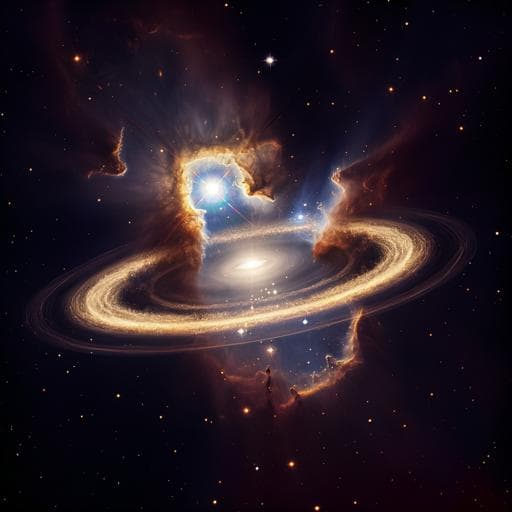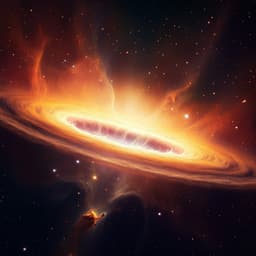
Space Sciences
A core in a star-forming disc as evidence of inside-out growth in the early Universe
W. M. Baker, S. Tacchella, et al.
Discover the morphologically mature galaxy JADES-GS+53.18343-27.79097, born in the first 700 million years of the Universe. This captivating star-forming galaxy features a compact core, an active disc, and a distinct clump, collectively shedding light on the intricacies of galactic evolution. This research was conducted by a team of talented authors.
~3 min • Beginner • English
Introduction
The study investigates how galaxies assembled their stellar mass and structural components at very early times, testing the long-standing prediction that galaxies grow from the inside out as lower-angular-momentum gas accretes and forms compact central components followed by higher-angular-momentum gas forming extended discs. Although local and z~1–3 observations often reveal inside-out growth, the detailed, spatially resolved build-up during the epoch of reionization (z ≥ 6) remains poorly constrained. Using JWST observations of JADES-GS+53.18343-27.79097 at z = 7.43 (~700 Myr after the Big Bang), the authors aim to characterize its resolved structure, stellar populations, and star-formation distribution to test whether inside-out growth is already operating and to assess whether such systems could be progenitors of quiescent galaxies at cosmic noon.
Literature Review
Background work shows that galaxies exhibit diverse morphologies organized along the Hubble sequence, with bulge-disc structures common. Spatially resolved studies in the nearby Universe and at intermediate redshifts (z ~ 1–3) commonly find inside-out growth, though both inside-out and outside-in sSFR profiles are observed. Theoretical expectations in ΛCDM suggest later-accreting gas has higher angular momentum, favoring extended disc growth, while mergers and feedback (stellar, AGN, cosmic rays) complicate morphology and star-formation regulation. At high redshift, elevated merger rates and feedback-driven compaction can drive central starbursts and rapid size fluctuations, especially in low-mass galaxies (10^7–10^9 M⊙), potentially flattening or inverting the size–mass relation. JWST has begun to reveal mature morphologies at very high redshifts, including bulges and discs and ultrared dusty discs, motivating resolved studies of early systems. The authors position their z=7.43 target within this context to directly test early bulge-disc assembly and inside-out growth.
Methodology
Data: JWST JADES observations in GOODS-S combining NIRCam imaging across nine filters (F090W, F115W, F150W, F200W, F277W, F335M, F356W, F410M, F444W) and NIRSpec MSA spectroscopy. Spectroscopy used PRISM/CLEAR (R~30–100, 0.7–5.3 μm; 11,292 s) and G395H/F290LP (R~2700, 2.9–4.2 μm; 8,009 s) with a 0.2″ × ~1.5″ three-shutter slitlet. Reduction followed JADES procedures; redshift derived from [O III]4959,5007 in R2700 spectrum (z_spec = 7.4303 ± 0.0002 (rand) ± 0.0005 (sys)).
Morphological decomposition: Forward-modelled all individual NIRCam exposures with ForcePho, fitting a three-component PSF-convolved model simultaneously across bands: (1) a compact central component (‘core’) with free Sérsic index 2–5, (2) an extended component (‘disc’) with n fixed to ~1, and (3) an off-centre clump (quasi-point source, radius ≤0.01″, n=1). Structural parameters (centres, sizes, axis ratios, PAs) constrained jointly; per-band fluxes fit independently to allow intrinsic colour gradients. PSFs approximated with Gaussian mixtures validated against WebbPSF and empirical PSFs. Model selection via image-plane χ² within segmentation maps and reduced χ² accounting for degrees of freedom; the three-component model yielded the best fit (χ² ~0.14; reduced χ² ~6.7), outperforming 1- or 2-component variants.
SED fitting: Extracted component photometry from ForcePho in all bands; fit each component independently with Prospector (FSPS/MIST, Chabrier IMF) using nonparametric SFHs (6 time bins with a recent 0–5 Myr bin), a two-component dust model with flexible attenuation law, and nebular emission. Priors included the standard continuity prior; a bursty-continuity prior test yielded consistent stellar masses. Derived masses, ages (t_half), SFRs averaged over 10 and 100 Myr, metallicities, and A_V per component. Verified component SEDs reproduce photometry including medium-band excesses (F410M) tracing Hβ+[O III].
Radial profiles: Constructed intrinsic (unconvolved) Sérsic profiles for core and disc, normalized to SED-derived stellar mass and SFR per component, to obtain radial Σ_* and Σ_SFR profiles and the combined sSFR(r). Computed half-mass radius for the core+disc system.
Spectroscopy cross-checks: Measured emission-line fluxes with PPXF on R100 spectrum; corrected for extinction using Hγ/Hβ. Compared synthetic photometry from spectrum to imaging; quantified line contributions to F410M and F444W. Derived dust-corrected Hβ-based SFR and gas-phase metallicity from strong-line diagnostics. Assessed AGN contribution via [O III]/Hβ ratio, line widths (Hβ narrow), and absence of strong high-ionization lines, finding no evidence for a dominant AGN.
Selection: Target chosen from z=7.0–7.8 JADES sources with F335M+F410M coverage and spectroscopic redshifts; selected for evident core-disc morphology and colour gradients; not a statistical sample.
Key Findings
- Discovery of a morphologically mature, star-forming core–disc galaxy with an off-centre clump at z_spec = 7.4303 ± 0.0002 ± 0.0005 (JADES-GS+53.18343-27.79097), when the Universe was ~700 Myr old.
- Three-component ForcePho model quantitatively preferred over simpler models (image-plane χ²: 0.14 for core+disc+clump vs 0.45 single-component, 0.25 core+disc, 0.18 galaxy+clump; reduced χ² lowest for the three-component fit).
- Sizes and structure: core half-light radius r_e = 16 ± 3 mas (~80 pc), Sérsic n ≈ 2.0 ± 0.4; disc r_e = 80 ± 16 mas (~400 pc), n fixed ≈1. Off-centre clump at ~1.4 kpc.
- Kinematics (from literature): ionized gas consistent with rotational support with v/σ ≈ 1.3 at r_e, supporting a disc interpretation.
- Stellar populations (Prospector):
• Core: log(M*/M⊙) = 8.38 ± 0.18; t_half ≈ 68 (+78/−78) Myr; SFR_10Myr ≈ 1.0 (+0.8/−0.8) M⊙/yr; SFR_100Myr ≈ 1.7 (+0.8/−0.8) M⊙/yr; log(Z*/Z⊙) ≈ −1.7 ± 0.2; A_V ≈ 0.02 (+0.07/−0.07) mag.
• Disc: log(M*/M⊙) = 7.98 (+0.25/−0.25); t_half ≈ 19 (+108/−108) Myr; SFR_10Myr ≈ 4.8 (+0.7/−0.7) M⊙/yr; SFR_100Myr ≈ 0.7 ± 0.3 M⊙/yr; log(Z*/Z⊙) ≈ −1.5 ± 0.5; A_V ≈ 0.08 ± 0.05 mag.
• Clump: log(M*/M⊙) = 7.22 (+0.42/−0.42); t_half ≈ 44 (+38/−38) Myr; SFR_10Myr ≈ 0.5 (−0.1/+0.2) M⊙/yr; SFR_100Myr ≈ 0.1 ± 0.0 M⊙/yr; log(Z*/Z⊙) ≈ −1.3 ± 0.4; A_V ≈ 0.13 (−0.06).
- Combined core+disc: log(M*/M⊙) ≈ 8.5 (+0.2/−0.2); SFR_10Myr ≈ 5.8 (+1.3/−1.3) M⊙/yr; log sSFR (yr⁻¹) ≈ −7.7 ± 0.1 (typical for z~7–8 SFGs). Hβ-based SFR ≈ 8.5 (+3.4/−7.7) M⊙/yr, consistent with SED-derived SFR_10Myr.
- Central compactness and densities: core stellar mass surface density Σ_* eff ≈ 6×10^9 M⊙ kpc⁻²; inner (R < 20 pc) density within ~0.2 dex of massive local ellipticals despite the galaxy being ~10^3 times less massive overall. At 1 kpc, the stellar mass surface density is ~2.8 dex lower than massive ellipticals.
- Radial profiles: Σ_SFR is dominated by the disc at nearly all radii; Σ_* dominated by the core in the centre. The combined sSFR(r) rises strongly with radius (~1.5 dex across the central ~1 kpc): stellar mass doubling time ~100 Myr in the inner ~100 pc vs ~10 Myr in the outskirts, demonstrating inside-out growth.
- Medium-band colour gradients (F356W–F410M redder outward; F277W–F356W bluer outward) indicate stronger nebular line emission and younger populations in the outskirts, consistent with the disc undergoing a current starburst.
- Gas-phase metallicity: 12+log(O/H) ≈ 7.86 ± 0.09 (strong-line), broadly consistent with expectations at this redshift; dust attenuation from Balmer decrement A_V,gas ≈ 0.8 (+1.2/−0.3) mag; disc A_V from SED ≈ 0.31 (+0.20/−0.13) mag.
- AGN assessment: [O III]/Hβ ≈ 4.5 and narrow Hβ lines consistent with star formation at high z; no evidence for a type-1 AGN, though a weak AGN cannot be fully excluded.
- Evolutionary implications: simple growth models (constant SFR profile vs inside-out scaling with R_e ∝ (1+z)^−1) both evolve the system onto the z~2 quiescent size–mass relation by z=1–3; the inside-out scaling track better avoids exceeding the maximum stellar surface density Σ_* ,max ≈ 10^11.5 M⊙ kpc⁻² and more closely resembles local ellipticals.
Discussion
The resolved structure and stellar populations of JADES-GS+53.18343-27.79097 show a dense, compact core that assembled early and a surrounding disc presently dominating star formation. The strongly rising sSFR profile and outwardly increasing nebular-line excess provide direct evidence that, even during the epoch of reionization, galaxies can grow inside-out: the centre has largely built its mass and is transitioning to lower specific growth, while the outer disc is rapidly forming stars. The system’s central densities approach those of present-day massive ellipticals despite its low total mass, indicating early establishment of dense cores. Evolutionary tracks based on the observed Σ_SFR profile suggest that with continued star formation—and particularly with inside-out growth that increases the SFR scale length—this system naturally evolves onto the size–mass relation of quiescent galaxies at z~2, and subsequently could become a present-day elliptical via ex-situ growth (mergers) that build the outer envelope. Two plausible formation pathways for the core are discussed: (1) continuous inside-out growth where an extremely compact early disc formed the present core, or (2) a compaction event funneling gas to the centre after initial disc formation, followed by disc re-growth. The lack of AGN signatures implies stellar processes dominate. Overall, the findings address the research question by demonstrating that bulge (core) formation and inside-out disc growth were already underway within 700 Myr of the Big Bang.
Conclusion
This work presents a z = 7.43 core–disc–clump galaxy with spatially resolved evidence for inside-out growth: a dense compact core coexisting with an actively star-forming disc whose sSFR increases with radius. The three-component structural model and component SED fits yield precise sizes, masses, and SFHs, revealing early core assembly and current disc-driven star formation. The observed profiles and simple evolutionary tracks indicate that such systems are natural progenitors of the quiescent population at z ~ 2 and of present-day ellipticals after further inside-out growth and later ex-situ envelope buildup. Future work should expand to statistically representative, mass-complete samples to quantify the prevalence of early core–disc systems, integrate spatially resolved spectroscopy to separate kinematics and emission-line properties by component, refine PSF/systematic treatments, and test more complex evolutionary models including feedback, compaction cycles, and merger histories.
Limitations
- Single-object, targeted selection (chosen for evident core–disc structure and colour gradients) precludes population-level inferences.
- Morphological decomposition is model-dependent; while three-component fits are quantitatively preferred, the solution is not unique. Sérsic n for the disc was fixed near 1 in the fiducial model; allowing n to vary introduces degeneracies with size.
- PSF approximations and deconvolution systematics may bias core-to-total flux ratios by ~5–10% (wavelength-independent), and sizes by ~10–20% (accounted for with error floors).
- Component SED fits assume negligible radial gradients within each component beyond the wavelength-dependent normalization and rely on priors that cannot fully break age–dust–metallicity degeneracies.
- NIRSpec slit covers core+disc but not the clump; spectroscopy thus cannot disentangle component contributions nor confirm the clump’s redshift spectroscopically (photometric redshift is consistent).
- AGN contribution cannot be completely excluded with current data.
- Evolutionary tracks are simplistic (assumed constant SFR or simple scale-length evolution) and do not include full feedback or merger histories.
Related Publications
Explore these studies to deepen your understanding of the subject.







